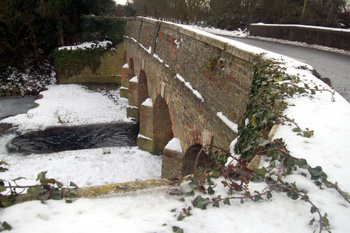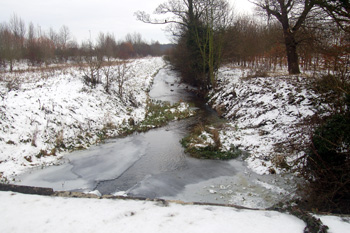Cardington Bridge

Cardington Bridge - Christmas Eve 2010
Cardington Bridge was listed by the former Department of Environment in May 1984 as Grade II, of special interest. It is built in various types of red and yellow brick and has stone keystones and coping to the parapets. The bridge has five arches with cut waters (projecting, tapering constructions designed to do as the name suggests). This particular bridge, we know due to an inscription, was built in 1778 by John Smeaton at the expense of Samuel Whitbread I. The inscription is over the three central arches on the west side and reads:
J Smeaton SW J Green
ENG 1778 SURV
The Dictionary of National Biography states that Smeaton was born in 1724 in Yorkshire, he also did work at Cardington Mills. He was educated at Leeds Grammar School and studied canals and harbours in the Netherlands. Most famously he built the third Eddystone Lighthouse between 1756 and 1759. Two previous lighthouses had been destroyed but Smeaton’s design was successful and durable and stood until 1887 when it was dismantled and replaced with the current structure. Parts of the lighthouse were reassembled as a monument on Plymouth Hoe. Smeaton died in 1792.
The earliest reference to a bridge at Cardington is in 1649 [WB/WF2/19/1] when a close of pasture called Bridge Pightle also Bulls Pightle lying near Cardington Bridge containing two acres was given by husbandman William Bull to his son William. A map of Elizabeth Whitbread’s estate in Cardington may show two bridges on the site of the present bridge [W2/2]. Certainly the river is cut in two places next to one another. One cut has the road running over it and the next has nothing, but may represent a smaller bridge for people on foot.
The bridge is little altered from Smeaton’s original design, which survives in the library of the Royal Society in London. The original design is for a ‘stone-arch bridge,’ but it is unclear whether this was expected to be constructed in brick and clad with stone. The bridge as constructed is largely in brick with limestone for the cutwater caps, keystones and copings.
It is 21 feet 6 inches wide and there is only a slight rise towards the middle, unlike earlier hump-backed bridges. Smeaton’s bridge was adopted by the county in 1888 [QDP9]. Before that time the bridge had, presumably, been maintained by the Whitbread family.
 View from Cardington Bridge Christmas Eve 2010
View from Cardington Bridge Christmas Eve 2010